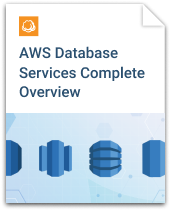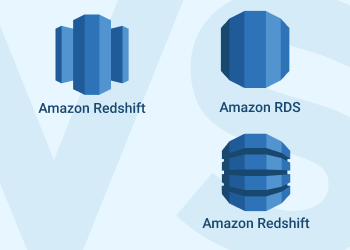Cloud database platforms are considered to be some of the best solutions in the world of cloud computing. While there are many reasons why they are exceedingly popular, high accessibility and security, plus dynamic flexibility are some of the principal benefits that come with cloud database systems. You don’t even have to worry about maintenance, hardware, or patching.
That said, Amazon Web Services is one of the most prominent options for both small-scale and large-scale users. This article provides an introduction to its corresponding RDS, Redshift, DynamoDB, and SimpleDB systems.
Table of Contents
Amazon RDS (Relational Database Service)
Amazon RDS, for starters, is the type of service you turn to when you need a standard database engine without the hassle of maintenance and administration.
In full, the solution is known as the Amazon Relational Database Service and it’s built to serve as a well-provisioned substitute for typical hardware databases. The whole system is not only high-performing and scalable but also extensively available thanks to its Availability Zones duplication.
In essence, the database engines you could leverage include PostgreSQL 9.3, 9.4, 9.5, and 9.6, SQL Server 2008 R2, SQL Server 2012 (SP2), SQL Server 2014, SQL Server 2016, and SQL Server 2017, Oracle Database v.11gR2, and 12c, MariaDB v.10.1.20, plus Amazon Aurora.MySQL v.5.1, 5.5, 5.6 and 5.7.


Amazon RDS Storage Features
Amazon RDS offers three varying attached storage systems for logs and databases. While Amazon Elastic Block Store (EBS) is their underlying tech foundation, each of the three variations comes with its own pricing, performance capabilities, as well as storage setup.
Applications of Amazon RDS
There are multiple instances where you could use Amazon RDS. Many organizations, for instance, choose the system because they happen to run a database with an identical engine, but they’d like to supplement it with an offsite solution.
You might also want to try out Amazon RDS if you’re handling a resource-intensive application that would require a scalable, durable, and fast database. Such a database can even be extended to accommodate extremely dynamic workflows.
All in all, Amazon RDS is a reliable option when you need a cloud database that’s capable of smooth and efficient data processing.
Amazon Redshift
Amazon Redshift is the king of handling large volumes of data. The system runs on PostgreSQL and it’s built to facilitate big data stretching to numerous petabytes.
In essence, the goal here is to provide an extensive cloud data warehouse for the convenient management of data. Consequently, this eliminates the need for complex onsite resources.
Now, it’s worth noting that Amazon Redshift’s architecture makes it a cluster database with multiple nodes. Then when you zero-in on further, it turns out each node avails Amazon Elastic Compute Cloud (EC2) virtual database instances. They essentially serve as basic units for facilitating your tasks.
Amazon Redshift Storage Setup
The cluster database framework on Amazon Redshift fundamentally avails two types of nodes – computing nodes and leading nodes.
As you’ve probably guessed already, the leading nodes are the primary request handlers. Upon receiving a user request, they proceed to create a processing code for computing nodes, before preparing an accompanying query and then submitting the whole thing to computing nodes.
Computing nodes then pick up from there by executing user requests and then relaying accordingly to the leading nodes, which ultimately complete the process by subsequently querying the response and transmitting the final result to the user.
Amazon Redshift Limits
Sadly, although large-scale data handling is Amazon Redhshift’s specialty, it turns out there are a couple of notable limits.
The number of users that can connect simultaneously to a cluster, for instance, cannot exceed 500. Then the accompanying database limit for each cluster is 60, while the corresponding maximum number of cluster tables is 9,900.
When it comes to subnets, their volume per subnet group cannot go beyond 20. Then active nodes, on the other hand, have a limit of 200.
Applications of Amazon Redshift
As we’ve established already, Amazon Redshift essentially serves as a data warehouse. That alone makes it suitable for extensive data and computing loads, which are commonly associated with enterprise databases as well as scientific processes.
Another area where Amazon Redshift is widely applied is big data analysis. Organizations take advantage of their ability to effectively store, analyze, plus transmit large volumes of data.
DynamoDB
DynamoDB is the go-to solution when you need a NoSQL database for handling small data that happens to be extremely dynamic.
Interestingly, the billing here is not based on hardware allocations. Rather, the principal determinant is the amount of data read and written by the system.
It’s also worth noting that DynamoDB doesn’t restrict your data storage capabilities. The allocations expand as the database volume increases, without instance duplication or any other standard mechanism for scaling cloud resources.
Now get this- the lack of final-performance scaling mechanisms, replication of data, and administering actions collectively translate to prolonged database durability. So, of course, you can bet DynamoDB is exceedingly robust and durable.
Unfortunately, however, that also comes with a major weakness. By partitioning data for increased durability, DynamoDB subsequently delays the re-write processes that replicate their preceding write actions. And that means you won’t be able to use this solution for intensive operations like advanced transactions as well as high-level querying.
Applications of DynamoDB
So far, DynamoDB is extensively utilized in gaming, blogging and messaging, advertising services, plus data blocks systematization and processing.
Therefore, in a nutshell, DynamoDB is worth considering if you’re involved in operations where data needs to be consistently accessible for processing as opposed to storage.
SimpleDB
Amazon SimpleDB is also a NoSQL database system, whose architecture happens to be a lot like DynamoDB’s. The main difference is that unlike DynamoDB, SimpleDB serves as a database core, which facilitates only the storage process, the query, as well as the basic non-relational index.
That consequently makes it a lightweight solution you can manage conveniently. But, unfortunately, it cannot match up to other database systems when it comes to storage, computing, and performance capabilities.
Applications of SimpleDB
SimpleDB is best leveraged as a simple database for undemanding data operations. And that, in other words, means serving as a supplementary database for advanced Amazon platforms, or alternatively, handling object metadata indexing and typical gaming data.
Conclusion
Now, to choose an ideal database platform from these four options, you should compare their respective administering depths, performance rates, database engines, and storage capacities. The ultimate goal is to identify the Amazon database solution whose computing infrastructure and overall flexibility is aligned to your organization’s needs. Download our whitepaper for AWS database comparison chart and a detailed overview of each service:






